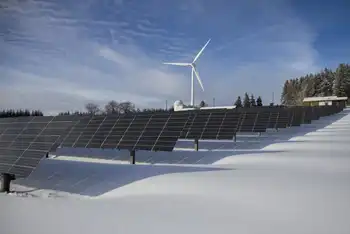Alberta group to push for CO2 sequestration
EDMONTON, ALBERTA - A 19-company group, led by Enbridge Inc. and including Edmonton's city-owned Epcor Utilities Inc., stepped forward as a candidate for proposed government aid to develop a greenhouse-gas disposal network.
"It could become a really meaningful industry," Enbridge Inc. technology vice-president Chuck Szmurlo said in describing long-range potential for collection, pipeline transportation and permanent underground storage of waste carbon-dioxide.
Ottawa and Alberta will be interested in supporting the new group if they follow recommendations by a national task force to set up a $2-billion fund for government investment in greenhouse-gas cleanups, Szmurlo predicted in an interview.
The venture includes a wide industry spectrum and aims to build a pioneer disposal site instead of only doing another in a long series of academic studies on the science of burying the fossil-fuel industry exhaust blamed for global warming, he said.
The new group, titled the Alberta Saline Aquifer Project or ASAP for short, ranges from electricity generator Atco Power and natural gas producer BP Canada to gas and oil transporter TransCanada PipeLines and oilsands plant builder UTS Energy.
A $750,000 study will identify a prime location, near a major emissions source and a leak-proof geological formation, for disposing of waste carbon-dioxide by the end of 2008, Szmurlo said.
Then the group's plans call for building a pilot plant for $20 million to $30 million.
The site will do practical demonstrations of permanently stowing about 1,000 tonnes a day of greenhouse-gas emissions into porous rock containing only salt water at a depth of 2,400 metres or more underground, Szmurlo said.
The proposed pilot plant will be "a significant stepping stone" towards disposing of waste carbon-dioxide on an industrial scale, Enbridge president Pat Daniel predicted in a statement.
After the initial field trial the next steps will be commercial projects about 10 times larger than the pioneer effort, Szmurlo said.
New pipelines would eventually link the industrial-scale sites into a provincial then national network with potential to become part of a North American greenhouse-gas disposal grid by hooking up to counterparts in the Unites States.
No dates were set for building jumbo disposal sites. The group aims to ensure continued growth of the fossil fuel industry by curbing forecast emissions increases from expanding Alberta oilsands and coal-fired power plants over the next decade to 25 years, Szmurlo indicated.
"Our goal is to accelerate carbon-dioxide capture and sequestration in Alberta and to jump start development of a carbon-dioxide pipeline that will be critical to its success," Epcor president Don Lowry said in a statement.
Enbridge formed the new group after about five years of unsuccessful efforts to obtain industry support for a $160-million plan to build a 400-kilometre pipeline network.
The scheme sought to collect 4,000 tonnes a day of pure carbon-dioxide from oilsands plants, refineries and petrochemical sites in the Fort McMurray, Edmonton and Red Deer regions. The proposed pipeline would ship the greenhouse gas to central and southern Alberta oilfields for injections to extend the life of aging wells.
"That hasn't gone away," Szmurlo said. But Enbridge learned that Alberta's growing industry will likely pump out more carbon-dioxide than enhanced oil recovery projects can use, he added.
Related News

Ontario takes constitutional challenge of its global adjustment electricity fee to Supreme Court
TORONTO - The Ontario government wants the Supreme Court of Canada to weigh in on a constitutional challenge being brought against a large provincial electricity charge, a case the province claims raises issues of national importance.
Ontario’s attorney general and its Independent Electricity System Operator applied for permission to appeal to the Supreme Court in January, according to the court’s website.
The province is trying to appeal a Court of Appeal for Ontario decision from November that said a legal challenge by Hamilton, Ont.-based National Steel Car Ltd. should be sent back to a lower-court for a full hearing.
Court reinstates constitutional challenge…




